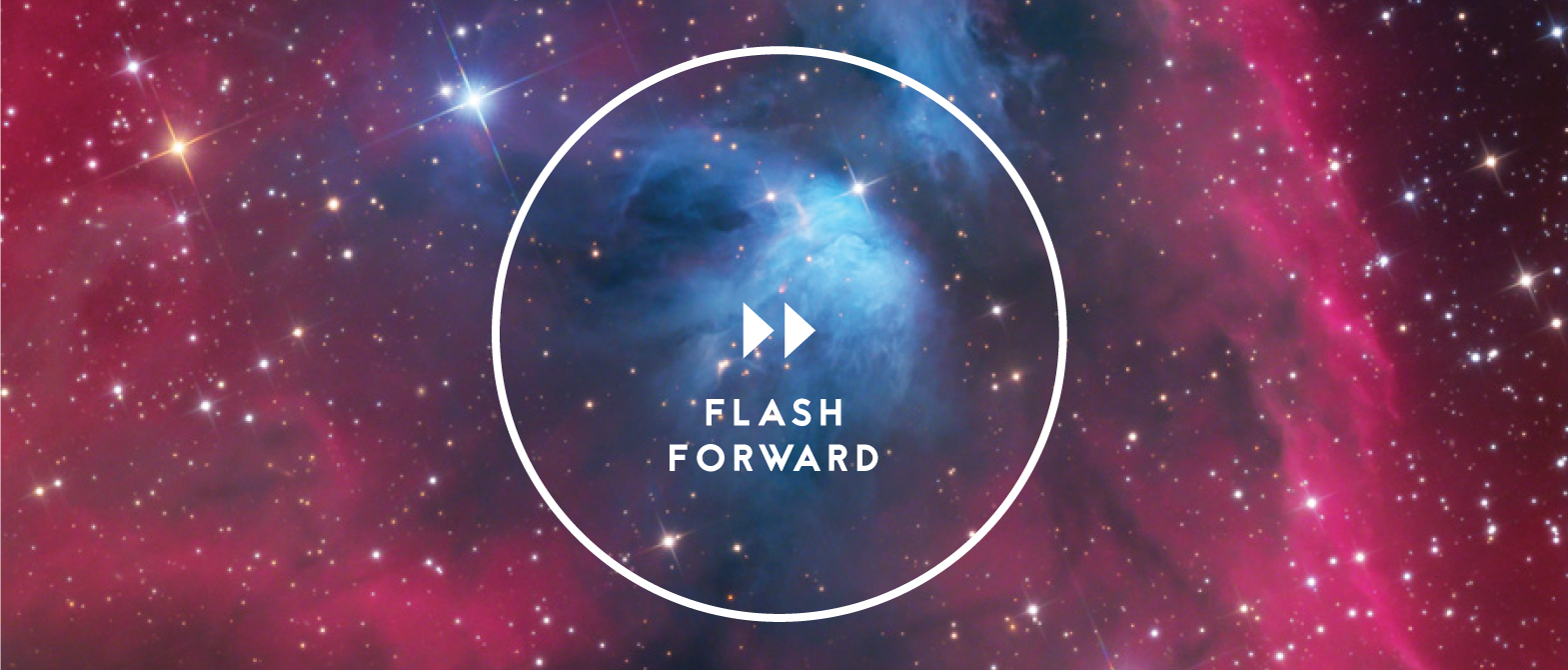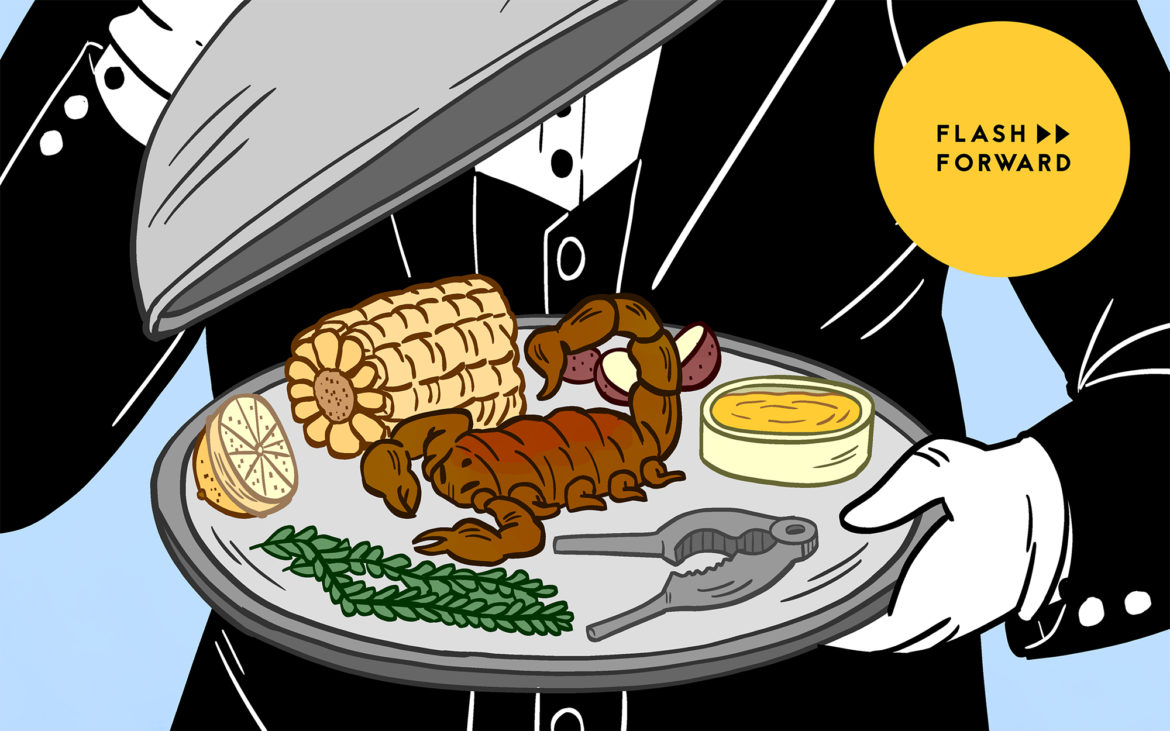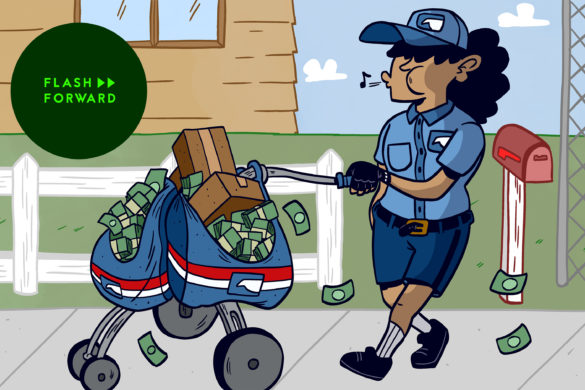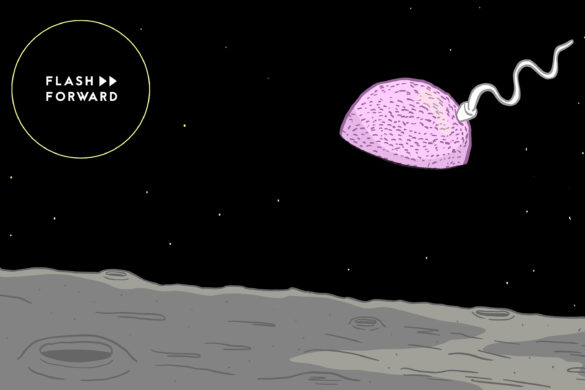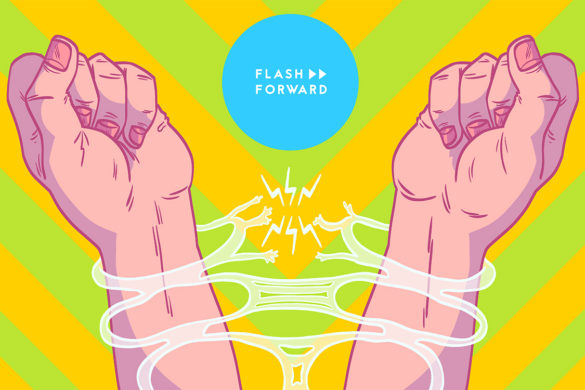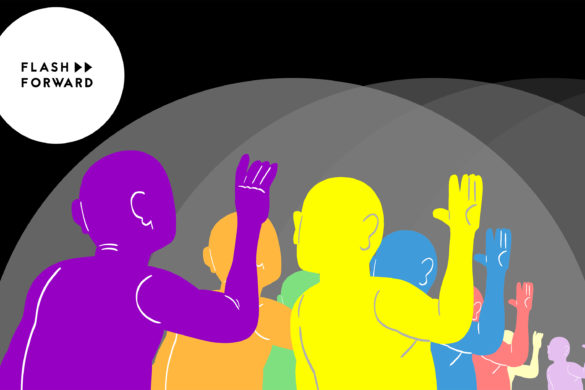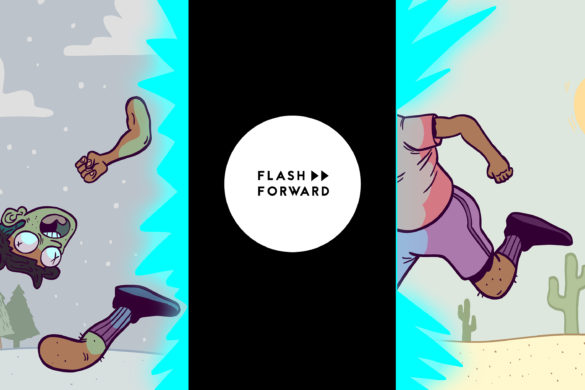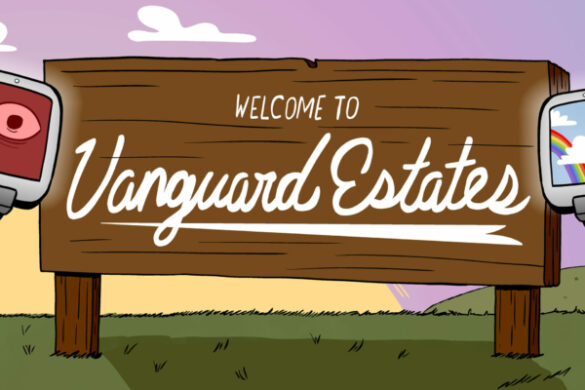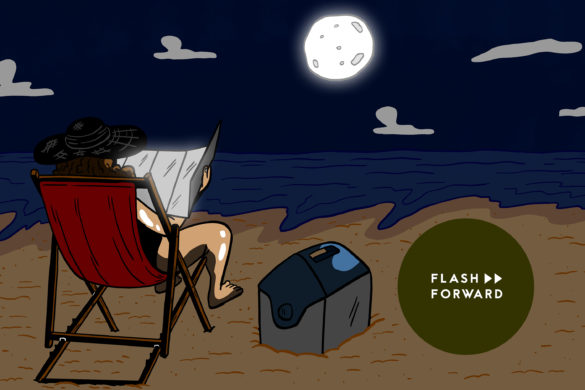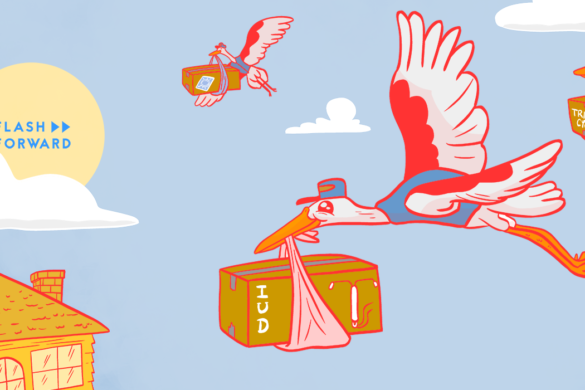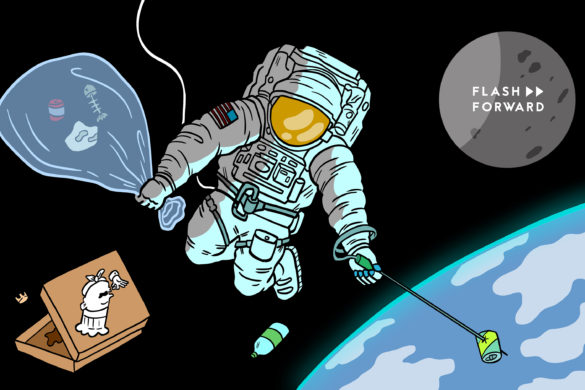Today we travel to a future where we become immune to every poison, venom and toxin in the world. What happens next?
Guests:
- Dr. Bryan Fry — biochemist and molecular biologist at the University of Queensland
- Dr. Christie Wilcox — science writer & author of Venomous: How Earth’s Deadliest Creatures Mastered Biochemistry
- Dr. Karin Broberg — geneticist at the Karolinska Institute
- Dr. Trysh Travis — cultural historian at the University of Florida
- Dr. Mark Bonta — cultural geographer
Voice Actors:
- Pharmaceutical Ad Narrator — Shara Kirby
Further Reading:
- Snakes evolve a magnetic way to be resistant to venom
- Prevalence of snakebite envenoming
- The socio-economic burden of snakebite in Sri Lanka
- Differences between poison and venom: An attempt at an integrative biological approach
- Poison vs. venom: What’s the difference?
- Frequently Asked Questions About Venomous Snakes
- Convergent evolution of pain-inducing defensive venom components in spitting cobras
- Groovy teeth, but was Sinornithosaurus a venomous dinosaur?
- Venomous Menace: Snakebite Treatments Are Failing in India
- Poison pass: the man who became immune to snake venom
- Mortal poison: the story of how venom works
- Bill Haast, a Man Charmed by Snakes, Dies at 100
- Biting back: Taking the sting out of spider venom
- Major Advance in Snakebite Treatment
- World’s first plastic antibody works in mice
- A Poison Aficionado’s Guide to 6 Killer Chemicals
- Abū Mūsā Jābir ibn Ḥayyān
- Arsenic: A Murderous History
- 6 Legendary Poisons and 1 Legendary Antidote
- Catherine Deshayes
- Poisoners Throughout History
- How the Body Defends Against Toxins in Your Environment
- Variation in Human Sensitivity to Arsenic
- Centuries of Poison-Laced Water Gave These People a Tolerance to Arsenic
- First-ever human population adaptation to toxic chemical, arsenic
- Arsenic Antidote Hidden In Our Genes
- Vaccines against drugs of abuse: where are we now?
- Altered methamphetamine place conditioning in mice vaccinated with a succinyl-methamphetamine-tetanus-toxoid vaccine
- Neurotransmitters in alcoholism: A review of neurobiological and genetic studies
- How Almonds Went From Deadly To Delicious
- Fugu: The fish more poisonous than cyanide
- Ethnobotany of Mexican and northern Central American cycads (Zamiaceae)
- The Cult of the Cycads
Note: Dr. Mark Bonta wanted to specifically thank a few collaborators on his cycad work: Elvia Tristán Martínez, Dr. Javier Fortanelli Martínez, Dr. María Teresa Pulido-Silva, Teresa Diego-Vargas, Aurelia Vite-Reyes, and Dr. Andrew P. Vovides
Episode Sponsors:
- Backblaze: Get peace of mind knowing your files are backed up securely in the cloud with Backblaze. Get a fully-featured 15-day free trial at: Backblaze.com/flashforward
- Shaker & Spoon: A subscription cocktail service that helps you learn how to make hand-crafted cocktails right at home. Get $20 off your first box at shakerandspoon.com/ffwd.
- Tab for a Cause: A browser extension that lets you raise money for charity while doing your thing online. Whenever you open a new tab, you’ll see a beautiful photo and a small ad. Part of that ad money goes toward a charity of your choice! Join team Advice For And From The future by signing up at tabforacause.org/flashforward.
- Tavour: Tavour is THE app for fans of beer, craft brews, and trying new and exciting labels. You sign up in the app and can choose the beers you’re interested in (including two new ones DAILY) adding to your own personalized crate. Use code: flashforward for $10 off after your first order of $25 or more.
- Purple Carrot: Purple Carrot is THE plant-based subscription meal kit that makes it easy to cook irresistible meals to fuel your body. Each week, choose from an expansive and delicious menu of dinners, lunches, breakfasts, and snacks! Get $30 off your first box by going to www.purplecarrot.com and entering code FLASH at checkout today! Purple Carrot, the easiest way to eat more plants!
Flash Forward is hosted by Rose Eveleth and produced by Julia Llinas Goodman. The intro music is by Asura and the outtro music is by Hussalonia. The episode art is by Matt Lubchansky. The voices from the future this episode were provided by
If you want to suggest a future we should take on, send us a note on Twitter, Facebook or by email at info@flashforwardpod.com. We love hearing your ideas! And if you think you’ve spotted one of the little references I’ve hidden in the episode, email us there too. If you’re right, I’ll send you something cool.
And if you want to support the show, there are a few ways you can do that too! Head to www.flashforwardpod.com/support for more about how to give. But if that’s not in the cards for you, you can head to iTunes and leave us a nice review or just tell your friends about us. Those things really do help.
That’s all for this future, come back next time and we’ll travel to a new one.
FULL TRANSCRIPT BELOW
(transcript by Emily White at The Wordary)
▹▹ ▹▹ ▹▹ ▹▹ ▹▹ ▹▹ ▹▹ ▹▹ ▹▹ ▹▹ ▹▹ ▹▹ ▹▹ ▹▹ ▹▹ ▹▹ ▹▹ ▹▹ ▹▹ ▹▹ ▹▹ ▹▹ ▹▹
FLASH FORWARD
S7E01 – “What If You Could Be Immune to Everything?”
[Flash Forward intro music – “Whispering Through” by Asura, an electronic, rhythm-heavy piece]
ROSE EVELETH:
Hello and welcome to the seventh season of Flash Forward! We’re back! I’m Rose and I’m your host. Flash Forward is a show about the future. Every episode we take on a specific possible, or not-so-possible, future scenario. We always start with a little field trip to the future to check out what’s going on, and then we teleport back to today to talk to experts about how that world we just heard might really go down. Got it? Great!
Just a quick note: this episode discusses drug and alcohol abuse. That part starts at about 35 minutes in.
Okay, this episode we’re starting in the year 2033.
FICTION SKETCH BEGINS
[upbeat, motivational music]
CONSUMER 1:
[outdoors, birds chirping] I can do more to keep myself safe in the outdoors.
CONSUMER 2:
[restaurant sounds] I can try almost anything, no matter how unusual.
CONSUMER 3:
[kids playing in the background] I can worry less when my kids are out of sight.
NARRATOR:
Mithrata is a one-of-a-kind, customizable injection that works against nature’s toxins. From snake venom to arsenic, Mithrata puts YOU in control. Simply ask your doctor for a personalized consult, and Mithrata technicians will formulate a vaccine to protect you against the poisons, venoms, and toxins you and your family might be exposed to. At work, at home, and in the outdoors, you can move through the world safely with Mithrata.
Mithrata does not replace antivenom. Do not intentionally ingest the chemicals affected by Mithrata, as your body may not be able to process certain doses. Even if you’re taking Mithrata, if you are exposed to high levels of toxins, seek immediate medical treatment.
[very rapidly] Do not take if you are allergic to Mithrata. Side effects can include dry mouth, constipation, drowsiness, hallucinations, and death. Talk to your doctor if you experience any of these side effects.
ALL CONSUMERS IN UNISON:
I can do almost anything, thanks to Mithrata.
NARRATOR:
With Mithrata, nothing is off limits.
Mithrata: Do anything.
[music fades down]
FICTION SKETCH END
ROSE:
Okay, so today we are talking about poison. And venom. And toxins. And all of the stuff that can kill you out there.
So here’s what happened. I was trawling through my big list of scientific publications that I like to read up on, and I came across a headline that read: “Snakes evolve a magnetic way to be resistant to venom.” And I could not scroll past that without clicking. So I read all about it and learned about how some snakes are immune to the neurotoxins of other snakes. And in fact, there are actually a bunch of ways that this kind of immunity can happen in snakes and in other animals. Which of course made me want to learn more about venoms, and poisons, and whether or not humans could at any point develop this same kind of immunity. Because if we could, that would be huge.
According to the World Health Organization, every year about five million people are bitten by snakes. About two million of those people develop illnesses after those bites, and over 100,000 people die.
DR. BRYAN FRY:
Antivenom is needed the most by the people who can afford it the least. It’s a classic poverty trap. Like in Australia, despite the Australian Tourism Board, virtually using Australian venomous animals as marketing, “Everything wants to kill you. Even this cute little, tiny mammal here wants to kill you, it just can’t.” In Australia, everything wants to kill you here. The annual death toll in Australia is what happens about every 10 minutes in India, every day, year in, year out.
ROSE:
This is Dr. Bryan Fry, a biochemist at the University of Queensland. And he says that even those who survive these snakebites are often left with chronic disabilities, amputations, damaged kidneys, and more. A couple of years ago the World Health Organization tried to calculate the socio-economic burden of snakebites in places like Sri Lanka. And they found that the impact of snakebite was on par with things like dengue.
BRYAN:
You have entire family groups being plunged into abject poverty because your typical antivenom requires refrigeration. Well, if you’re out in Agumbe in the Western Ghats of India, the power supply is intermittent at best. So, antivenom is going to be stocked in the major cities with constant power supply, so people may be hours or even days away.
ROSE:
And on top of all of that, snakebite research has been largely neglected. In fact, in 2009, the World Health Organization added snakebite to its list of neglected tropical diseases. In 2010, the medical journal The Lancet published a piece arguing that “The burden of human suffering caused by snakebite remains unrecognized, invisible, and unheard by the global public health community, forgotten by development agencies and governments alike.”
So if we could make humans immune to snakebites, if we could inoculate people against these toxic compounds, we could save a lot of lives. But is that even possible?
To answer that, we first have to do some definitions. What is poison? What is venom? Are they both toxins? What’s going on here?
DR. CHRISTIE WILCOX:
It is all very confusing and there are entire papers written about, like, what counts as venomous versus what counts as poisonous.
ROSE:
This is Dr. Christie Wilcox.
CHRISTIE:
And I’m a science writer now; reformed biologist who studied venom.
ROSE:
A couple of years ago, Christie wrote a book called Venomous: How Earth’s Deadliest Creatures Mastered Biochemistry.
CHRISTIE:
Poisons and venoms are both toxic substances. Poisons are usually the ones that can enter via your skin, or ingestion, or inhalation. So they are things that, sort of, passively make their way into your body. Venoms are the ones that are introduced through a wound. And so whether that’s the little, teeny, tiny micro-needle of a jellyfish stinger or whether it’s a big snake fang, the animal is really actively introducing it pretty much straight into your bloodstream.
BRYAN:
If you bite it and you die, it’s poisonous. If it bites you and you die, it’s venomous.
ROSE:
Now, because nature loves to defy all of our efforts at categorizing and making rules, there are some weird in-between creatures.
BRYAN:
Like the blue-ringed octopus delivers tetrodotoxin by biting, so therefore it’s a venomous animal. However, if you eat it, you’ll absorb the tetrodotoxin, in which case it becomes a poisonous animal.
ROSE:
Now, you might have heard that you can drink snake venom because snake venom is only dangerous if it gets into your bloodstream. And this is true in theory for some snake venoms. With a very large asterisk.
BRYAN:
You can drink, you know, all the venom you want, like a toothless idiot showing off rattlesnake roundups. But if they happen to have a bleeding gum or an ulcer, then the venom can enter.
ROSE (on call):
How would you know that you don’t have an entry point? How would you be confident of that?
BRYAN:
Well, there’s one extremely efficient way of finding out. (laughs)
ROSE (mono):
Listener, please, I beg of you. Do not drink snake venom. It is just not worth it. Okay? Great.
So one of the reasons that venom and poison are so interesting to biologists, aside from being dangerous and cool, is that they actually provide a really amazing look at evolution.
CHRISTIE:
We tend to see what they call convergent evolution. So we see the same kinds of proteins or the same kinds of toxins being co-opted again, and again, and again because they do certain things that are very helpful. Like you might see ones that affect coagulation of the blood, because if something can’t coagulate its blood, it’s going to bleed out, and then you’re going to have a meal that works really well.
Or you might see something that, you know, affects nerves because you stop somebody’s nerves from working and they’re going to be paralyzed. Like, there’s nothing they can do. And so you see this, like, convergent evolution happening over and over again. And it gives scientists this opportunity to sort of peel back the curtain and look at how that kind of trait evolves.
ROSE:
Venom and poison have both evolved in so many ways in so many different creatures.
BRYAN:
There’s even evidence for venomous dinosaurs with hollow, cobra-like teeth that were suspected to be specialist predators on some of the early birds.
ROSE:
For what it’s worth, not everybody is 100% in agreement about the venomous dinosaur theory, but that is a debate for another episode. Today, there are venomous jellyfish, and sea urchins, and even venomous regular fish.
BRYAN:
The most pain that I’ve ever been in was my first stingray envenomation, which was a really big ray that put its barb straight into the meaty part of my thigh all the way down to the bone. You know, they are mind-blowingly painful, which fits with the fact that they’re trying to defend themselves against things like tiger sharks or killer whales.
ROSE:
There are also venomous mammals. The slow loris, which you may have seen in videos on the internet, is venomous. There is also a venomous shrew that lives in Siberia. Platypuses – Platypi? Don’t know the plural of that – They’re venomous!
But just because all of these different creatures evolved venoms and poisons doesn’t mean that all snakes, or poison dart frogs, or stingrays have the same kind of poisons or venoms. In fact, there is a huge variety in the different types of compounds that these creatures use. And one thing that totally blew my mind is that there can even be variation between two individuals that are actually the same species.
BRYAN:
We’re doing a lot of work with the Southern Pacific rattlesnake outside of Los Angeles, where if you look at the venom of the snakes down near the desert floor, where when they bite like a kangaroo mouse, they have the luxury of tracking it for long distances across the sand, so there’s not a great chance of prey escape. So they can bite, release, and then just let it die at its leisure and scent trail and follow it.
But if you go up to the top of the San Jacinto Mountains, basically just driving two-and-a-half hours virtually straight up, the snakes have specialized for living on the ridges up there, all these granite boulders with deep cracks. So there’s a high chance of prey escape and that selection pressure meant that they have a completely different venom than the ones down at the lower altitude.
ROSE:
In fact, rattlesnake antivenom developed for some types of rattlesnakes might not work as well if you get bit by a different type of rattlesnake.
BRYAN:
My mate, Sean Bush, when he was an ER physician at Loma Linda Hospital, was having patients die on his ER table, despite giving them 60-70 ampules of antivenom over a three-to-four-hour period, which is an insane amount of antivenom. And he might as well have been running water in for all it did.
ROSE:
Now, one thing you may have heard that I actually thought was true until I talked to Bryan, is this idea that baby snakes are more dangerous than adult snakes. I had always learned that adult snakes will do “dummy strikes,” where they don’t waste their precious venom if they can scare you away without it. Venom takes a lot of energy and resources for an animal to make so they don’t want to waste it. But baby snakes, the story goes, haven’t figured that out yet so they are more likely to actually envenomate you. Turns out that is not true.
BRYAN:
Total myth. And nor is their venom necessarily more potent. The venom, however, can be completely different. Like in Australia, we have a problem with the brown snakes because the adults are specialists on mammals, so their venom is specific for causing blood clots, and they turn the blood system on, and so they immobilize their prey by causing stroke. The babies, however, are specialists on lizards, so their venom is neurotoxic. So the antivenom made using the venom of the adults doesn’t work against the venom of babies because of that radical difference in venom biochemistry.
ROSE:
And this is where we get to the big conundrum of my idea to vaccinate people against snakebites. Because even if we are just talking about snakes, the different compounds and toxins in each snake venom can be really different.
Even today, certain antivenoms developed in one place, on one population, don’t work in other places where the snakes are different.
BRYAN:
Also in India, most of… actually, currently, all the venom being used for antivenom comes from the Madras Crocodile Bank.
ROSE:
Madras, or Chennai, is a city on the southeastern coast of India, which means that the antivenom being made there is made using snakes from that area.
BRYAN:
So the antivenom fails if you go North India. They’ve got a big problem.
ROSE:
As of 2012, there was only one company producing antivenom in all of Africa. It was located in South Africa.
BRYAN:
Particularly for this type of snake called a saw-scaled viper that’s arguably the most medically important snake in the world.
ROSE:
But antivenom is expensive, and again, often the folks who need it most are the ones who can least afford it.
BRYAN:
So the Indian antivenom manufacturers, without doing any testing have been… They started selling their antivenoms in Africa, antivenoms that were already shown to have issues, regional issues within India, saying, “You have saw-scaled vipers, we have saw-scaled vipers, you know, let’s make a deal.” Well, once they started doing that, death rates in Kenya, for example, skyrocketed.
ROSE:
Even though the antivenom is from the same species of snake, it doesn’t work as well. And yet, these way-less effective antivenoms are still sold today, even though studies have shown that they don’t really work.
But even besides all of the different specialties and regional variations between snakes, there’s also this big question of, “Can humans even develop an immunity to stuff like this?” The answer is… it’s complicated. In theory: maybe.
CHRISTIE:
It’s really a question of amount. So, snake venoms in principle aren’t all that different from, say, a virus or a bacterium, at least in the way that your body responds to them. It sees these toxins as foreign material. It tries to develop antibodies to attack them. Theoretically, if you were being introduced to small amounts of snake venom constantly all the time, could you build up enough circulating antibodies to withstand a larger dose of venom? Theoretically, yes.
It’s the same idea as a vaccine in that way. The intricacy of it, of course, is very, very much more complex and nuanced than that, and it is very, very difficult because these venoms, they aren’t just one or two toxins like a vaccine is against one or two viruses. These are dozens, hundreds, sometimes thousands of different toxins, so you’re talking about needing to have a lot of antibodies being produced against a wide variety of toxins.
ROSE:
There are people out there who intentionally inject themselves with snake venom with this idea that they could develop some kind of resistance. But there’s not a ton of good evidence that this works reliably. There is one guy who I’ve read about, and who Bryan mentioned, who maybe did successfully do this.
BRYAN:
An absolute legend called Bill Haast, who was the owner of the Miami Serpentarium. He was milking and supplying snakes for research in the ‘50s through the ‘70s and ‘80s. I remember going there and seeing him. He was amazing. He injected himself with venom, because he had a dramatic occupational hazard, where he built up resistance to venom. But he was working with snakes for which there was no antivenom, so he had a legitimate reason.
ROSE:
Bill lived to be 100 years old, and he’s the guy that a lot of people point to as proof that this works. But in general, especially when it comes to hobbyist snake keepers who are doing this, it is just not a good idea.
BRYAN:
He lived a long time despite the investigations. But people point to him, say, “Look, he lived a long time because he was injecting venom.” But if you look at, like, the horses that are used for antivenom production, they have shorter life spans than a horse that has not been regularly injected with venom. Now, venom is very hard on the body. You know, funny that.
ROSE:
And again, even if this did work, it would probably only work on a very specific species or population that you used as your source venom. So you might be immune to rattlesnakes in the desert, but if you climb up the hill? No guarantees.
Now I had this other weird idea that I threw at Christie. What if biochemists and biologists got together and figured out how to give humans a special organ that could detect snake venom and generate antivenom in response? Like, if we don’t need our gallbladder, what if we replaced it with an antivenom organ?
CHRISTIE:
My instinctual answer is that it would be an issue of volume, because to have antivenom against all the possible snakes that could bite you, or all the… like, if you were trying to do it against all species of venomous snake, you would have so much needed to be, sort of, on-demand and sitting in there. I’m trying to think, if you had, like, a living cell organ or something where the cells were just designed to pump out these antibodies, I could see that happening. But then again, when you get bitten by a cobra or something, I mean, we’re talking not just, like, a single little injection. Usually we’re talking vials and vials, sometimes dozens of vials of antivenom. And so you would need a lot of volume.
ROSE:
Really, if we wanted to make people “immune” to snakebite or other kinds of venoms and poisons, the key is to actually have antivenom and treatments available for everybody all around the world. Which is no small feat. For one thing, most of them require refrigeration, which not everybody has access to. But there are people working on this problem. Some people are trying to develop something like an EpiPen for snakebite.
CHRISTIE:
Even if it’s just a bridge to care. Even if it’s just… You know, you do the EpiPen and then you get your butt to the hospital. But the point is that if you had that for snakebite you could get people through that three-to-four hours to the hospital, or those couple of days to get everything together to go to the hospital. And that would make it so that a lot more people would make it through a bite if they were able to actually have that.
ROSE:
Other people are working on a pill version of this idea.
CHRISTIE:
That’s the dream, right? Is that, like, you could immediately inject yourself with something or, you know, swallow a pill or something that would neutralize the venom and you’d be totally fine.
ROSE:
And there are some even weirder versions of this idea floating around out there.
CHRISTIE:
There’s one group, I think in California, that is looking at trying to make, basically, plastic antibodies. So they make these nano-polymers or whatever out of different subunits of just, like, carbon-based subunits. But they’re their hydrocarbon, so they’re essentially plastics. And they just have them build around toxins. And so then they act kind of like antibodies in that they bind toxins. They did, like, a proof of concept to this with bee venom, with melittin, which is the main toxin in bee venom. And yeah, it worked. It saved mice lives.
ROSE:
So my hopeful theory about how we could maybe make everybody immune to even just snakebites is … maybe a little fanciful. But there are cases where humans have figured out ways around other kinds of toxic substances. And when we come back we’re going to talk about those cases, and what it might mean for the idea of immunity in the future. Plus, a whole bunch of historical poisonings.
But first a quick break.
ADVERTISEMENT: BACKBLAZE
This episode is supported in part by Backblaze. Get peace of mind knowing your files are backed up securely in the cloud with Backblaze.
Listener, I hope that you have never had the experience of having a computer or a hard drive fail and realizing, “Oh my god! All of my important stuff is on there and I have no idea how to get it!” There’s this horrible panic, that feeling that you maybe might throw up. It’s so bad. If you’ve been there, you know. And if you haven’t, please just trust me, you don’t want to be there.
The best defense against this nightmare is offense by backing up your files. And that’s where Backblaze comes in. For just $6 a month, Backblaze offers unlimited computer backups for Macs and PCs. You can back up documents, music, photos, videos, drawings, projects, all of your data. You can restore files anywhere, directly download them on the web, or restore them by mail on a hard drive. And if you’re worried about accidentally deleting files, you can increase your retention history to one year for just an additional $2 a month. Backblaze even has a mobile app to access and download your files on the go.
To date, Backblaze has restored over 50 billion files for customers. And if you want to back up your files, you can sign up for a free, fully-featured, no-credit-required trial by going to Backblaze.com/FlashForward. That’s Backblaze.com/FlashForward to get a fully-featured, 15-day free trial. So go there, play with it, start protecting yourself from potential bad times. You can start today.
ADVERTISEMENT END
ADVERTISEMENT: FLASH FORWARD BOOK
Hello! It’s Rose, and I am here to do an advertisement on my own podcast for my own book. It’s like the snake eating its tail.
If you are a longtime listener, you have heard me talk about this book a lot, but I am here to tell you that it is almost officially out in the world. The Flash Forward book is basically everything that you love about this show but in a different format. Every chapter begins with an incredible, illustrated comic created by an amazing artist. There are 12 chapters, 12 different artists, 12 unique and amazing looks into the future. And then after each comic, you will hear from me about that future. You’ll hear where the science, or the tech, or the policy is right now and what it might mean for the future. I am really, really proud of the book and I really hope you pick up a copy.
If you are thinking about getting the book, please consider pre-ordering it. Pre-orders are really, really important for authors because they, basically, help tell bookstores, and online sellers, and agents, and publishing houses that the author has people who want to buy the book. Plus, if you pre-order, you can get an amazing sticker page full of little illustrations from the book turned into incredible stickers. You can go to FlashForwardPod.com/Book for more about all of that.
The book comes out officially on April 20th and I will be doing some book events around that time as well. When I have those dates officially set, I will post about them on the show’s Instagram, and Facebook, and Twitter pages. And also, for everything you ever need to know about the book, again, go to FlashForwardPod.com/Book. Thank you!
ADVERTISEMENT END
ROSE:
Okay, so if we could be immune to snakebites and jellyfish stings and all of that stuff, it would definitely be good for humans. But what about the animals that have these defenses for a reason? What if we no longer feared snakes, or spiders, or any of the other poisonous or venomous things out there? When I first emailed Christie about this I thought that maybe it would be bad for these creatures. I mean, humans have occupied and destroyed so many environments. If we no longer feared being bitten or stung, would we feel even more brazen and just totally take over everything?
CHRISTIE:
You know, honestly, I don’t think it would be that bad for them, if at all. One of the reasons that we have such a fascination with them, that we mess with them, that we interact with them, is because of their danger to us.
ROSE:
Humans tend to be pretty, I don’t know, let’s say proactive, at getting rid of things we see as a threat.
CHRISTIE:
In some places, like in the southern US, you have these rattlesnake roundups where they go out once a year and try to kill as many rattlesnakes as they can because they are seen as a danger. They are seen as a harm. They are seen as something that is posing a problem to people. And so why not get rid of them?
ROSE:
If we were immune, maybe we would just leave them alone. Which, by the way, is what most experts recommend anyway because snakes didn’t develop venom for you, they do not want to bite you. They really don’t want to be near you at all.
CHRISTIE:
People who see a venomous snake… you know, they see a rattlesnake under their porch. They often… They have this urge to get rid of it or to harm it. And it just makes me sad. Like, I wish that more people, like, maybe call someone to get it removed, but someone who isn’t going to kill it because they really don’t want to do anything to you. That’s not their goal in life. You are a bigger problem for them and a waste of their venom that they had to work so hard to make, you know? So yeah, that’s just… I wish everyone appreciated how absolutely incredible these animals really are.
ROSE:
Okay, so we probably can’t develop an immunity to all snake venom, or all poison dart frog poison, etc., etc. But what about other forms of poisons or toxins that aren’t delivered by a living creature?
[clip from The Princess Bride:]
Vizzini: I smell nothing.
Man in Black: What you do not smell is called iocane powder. It is odorless, tasteless, dissolves instantly in liquid, and is among the more deadly poisons known to man.
Vizzini: Hm.
DR. KARIN BROBERG:
It’s tasteless. It’s odorless. So it’s very good poison if you have that purpose.
ROSE:
This is Dr. Karin Broberg, a geneticist at the Karolinska Institute in Sweden. And the poison that she is talking about is not iocane powder. It’s arsenic.
KARIN:
And it has been used as a poison throughout history. One of the Swedish kings, for example, in the 16th century, was killed with arsenic in the pea soup. And they actually opened his grave in the 1950s just to prove if this was true. It had been a myth for a long time, and yes, they found high concentrations of arsenic in the remains of his skeleton.
ROSE:
Arsenic occurs naturally on Earth, and it’s sort of the perfect poison to use to kill someone because it can act really slowly, and a lot of the symptoms of arsenic poisoning, things like vomiting and diarrhea, can be caused by lots of stuff. So if you want to kill someone on an extended timeline and have plausible deniability, arsenic is a great choice.
Now, I’m about to tell you some stories about arsenic poisoning, but I should say that a lot of the stories that out there exist are, uh, let’s say, disputed by historians. For example, you will often read in stories that arsenic was first isolated by an alchemist named Jabir ibn Hayyan in the early 1800s. But if you look into this, historians actually say that they are not totally sure that Jabir ibn Hayyan was a single person. There is this thing called the Jabirian corpus, which is a huge compilation of texts about chemistry, alchemy, numerology, philosophy, mechanics, pharmacology, and more. But whether one single person actually wrote all those texts, is unclear.
But regardless of whether Jabir ibn Hayyan was one man, or a group of people, or whatever it is, historians do think that by the 1400s, people were using arsenic to poison each other pretty regularly.
When you fast forward to the 17th century, arsenic was so commonly used to take out wealthy rivals and members of the French bourgeoisie that they actually started calling it ‘inheritance powder’. There was even a fortune-teller named Catherine Deshayes, or ‘La Voisin’, who sold a mixture of arsenic, belladonna, aconite, and opium to French noblewomen who wanted to off their terrible husbands. La Voisin was at the center of a whole tribunal set up by King Louis the XIV who was like, “Okay, this poisoning stuff has gone TOO FAR. We have to end this.” By the end of the tribunal, 36 people were sentenced to death and La Voisin was burned at the stake. Although, I really think… I mean, if you’re going to kill her for poisoning people, you probably should poison her, right? I don’t know. That’s just me.
Anyway, there are so many weird and cool arsenic poisoning stories to talk about, and we won’t go through them all here, but I’m going to talk a bunch more about them on the bonus podcast this week, including a Roman woman named Giulia Tofana whose arsenic poison was behind the death of 600 people, including two popes. If you want to get that bonus podcast, you can become a supporter either on Patreon or as a member of the Time Traveler club. You can learn more about those things at FlashForwardPod.com/Support.
The point of all of this is that powerful people have feared being poisoned for a long time. And there is even a probably apocryphal story about immunity to poison. This one goes back about 2,000 years to a kingdom called Pontus, which was located where Turkey is now. Pontus was ruled at the time by King Mithridates, and Mithridates was terrified of being poisoned. And this was not, in fact, an irrational fear. His mother had indeed poisoned his father. But Mithridates was like “Mm-mm. Not me. You’re not going to get me with the poison!” And he spent years trying to build up a tolerance to various poisons and toxins by consuming tiny amounts of them over time. He was so obsessed with this that he’s now known as the Poison King, and this idea that you could build up immunity with this method is called Mithridatism.
Now the twist of this story, and I should say that this is possibly more of a tale than what really happened in actual history, but the story goes that when the Romans invaded Pontus and it became clear to Mithridates that his side was going to lose, he tried to poison himself before he could be killed by his enemies. But of course, it did not work because he had spent all this time building up immunity and he had to ask one of his soldiers to kill him instead.
Okay, enough history. Can you actually develop a resistance to poison like this? The answer is… it’s complicated, but possibly yes. However, most likely not in the way that Mithridates did. You actually need a little bit of help from evolution, too.
KARIN:
I mean, you find all kinds of metals in the Andes. There’s a lot of mining there because you can find gold and silver, et cetera, but there’s also arsenic in the drinking water. Not in every place, but in some places.
ROSE:
The amount of arsenic in the water in the Andes isn’t high enough to just kill you outright. But even smaller doses, over long periods of time, can be really bad for you.
KARIN:
Arsenic can do a lot of things. It’s one of the most potent carcinogens. It causes cancer, seven different types of cancer. But it also does a lot of other things. It can cause liver toxicity, damage the liver, and it has been associated with diabetes, cardiovascular disease. In children, if they are exposed early in life, you see increased mortality and increased lung disorders.
ROSE:
The human body has a method to deal with toxins like arsenic. What it does is try to, essentially, shepherd the chemical through the body and out, either through urine or poop. And to do that, the body has to prevent the arsenic from binding to anything on its way through your system. And the way our bodies try to do this, to shepherd this arsenic through without it binding to anything, is basically by sticking on two extra molecules. But there’s sort of a cruel catch to this method.
KARIN:
If it gets two molecules, two so-called methyl groups, it goes faster through the body than one. But if it only gets one molecule, it gets much more toxic.
ROSE:
It’s sort of like those carnival games where the slot for the maximum prize is surrounded by “Game Over” slots.
KARIN:
This is a double-edged sword. You want to get rid of it, but at the same time you make it more toxic.
ROSE:
Everybody’s body has a different success rate at this game. You and I, for example, probably have a different rate of arsenic metabolism. But there is one group of people who is distinctly better at metabolizing arsenic. That’s people who live in the Andes mountains. What Karin and other scientists have found is that over thousands of years of evolution, these small, remote populations have become better and better at dealing with arsenic. This is actually the first evidence of human adaptation to a toxic chemical ever found.
It is not, however, the first species they have discovered to develop an arsenic resistance. And this is super fascinating because Karin also did a study looking at the evolution of this resistance across all kinds of species, from humans all the way to algae. And what they found is that human tolerance to arsenic didn’t come from some recent ancestor along the evolutionary tree the way that we usually imagine.
KARIN:
So what we have shown is a phenomenon called transfer directly from bacteria to animals during evolution. So we have somehow incorporated the DNA from bacteria directly into our genome or into the animal genome.
ROSE:
This is called horizontal gene transfer, and it’s basically a way in which animals, kind of, grab something from the bacteria that they encounter, like it’s a little genetic buffet. “I’ll take a little bit of this, I’ll take a little bit of that, and a little bit of arsenic resistance.”
Now, it’s important to say that these folks in the Andes are not immune to arsenic. They can and do still suffer from the negative impacts of the compound in their water. And Karin says that some people have taken their results to mean that these communities don’t need clean water at all.
KARIN:
They used our study as an argument for not treating the water, because “they said that you are immune.” So, I was very sad about this because that was not what we said. It was misused.
ROSE:
It’s really important that we make sure these folks have safe drinking water, especially as climate change makes their water supplies even more tenuous.
Karin’s group also looked at the genetics at work here and identified a region of the DNA that is probably responsible for conferring this resistance. And so I asked her: in the future, could we potentially use CRISPR to give everybody resistance to arsenic? And I thought that she would, kind of, laugh at me about this idea, but she did not.
KARIN:
I think it’s something that actually could happen within 20 years. It would be an advantage to have a genetic setup for certain environments, definitely. It could be to take some tough work that no one else wants to take, or actually to resist certain diseases, or also air pollution, or stress. I think people would be interested, just as interested as they would be to get their hair back if they go bald, or… I mean, there are many possibilities with CRISPR.
ROSE:
So maybe in the future we can use genetic editing to give ourselves a little bit of help managing this increasingly toxic world we live in. It’s not Mithridates eating tiny bits of poison, and it’s not guys injecting themselves with snake venom, but it’s probably a lot more effective than either of those things.
Okay, so we’ve talked about venoms and poisons that come from things that you don’t really want to deal with – snakes, stingrays, arsenic, scary stuff. But there are also types of poison that many people partake in all the time. And when we come back, we are going to talk about the poisonous stuff that we eat, and drink, and smoke, and what it would be like to be immune to all of that.
But first, a quick break.
ADVERTISEMENT: TAB FOR A CAUSE
All right, so let’s imagine for a moment that you are an astronaut and you want to get on the internet, obviously, so you can watch TikToks or whatever it is. And you can do that, it just takes a while. Astronauts on the ISS have to use a remote desktop tool on computers on the ground that have access to the internet. So every click has to go from the ISS to a geosynchronous satellite, back down to the ground. Then the actual click on the machine, they have to wait for the web, and then back up to the geosynchronous satellite, and then back over to the ISS. What that means is that even just moving a mouse around is slow because there are all these steps.
That fun fact comes from Patron William Andrews. But thankfully, you probably do not have to wait that long to browse the internet. It probably takes you, like, a second or less to open up a new tab and search for something. And if you use Tab for a Cause every time you open up a new tab, you can raise money for charity. With the Tab for a Cause extension, whenever you open up a new tab you will see a beautiful photo and a very small ad. Part of that ad money goes towards a charity of your choice. And you can join team Flash Forward by signing up at TabforaCause.org/FlashForward.
ADVERTISEMENT END
ADVERTISEMENT: KNOWABLE
What do NBA All-Star Chris Paul, NASA commander Scott Kelly, and super smart podcaster Kristen Meinzer have in common? They all have incredible experiences, and they have taken those experiences and crafted audio courses to teach you what they have learned. Those audio courses are on Knowable, which is a new app where the world’s top experts teach new skills in bite-sized audio courses.
It’s sort of like someone took a podcast, added audiobook, and put them in, like, a pressure cooker, and then stood back and released that pressure with a totally normal and not-terrified facial expression, and what they got were little snippets of pure, distilled learning.
NASA commander Scott Kelly teaches lessons learned from a career in space. NBA All-Star Chris Paul discusses the performance benefits of his plant-based lifestyle. And podcaster Kristen Meinzer tells you everything she has learned about how to be happier from years of research.
Knowable is accessible on your phone and on the web, and each audio course is broken out into individual lessons, usually about 15 minutes long. You can explore at your own pace, and each class is supported by downloadable materials, lessons, recipes, and more. I know that you like learning, okay? You don’t have to lie to me. We are friends, sort of. And this is a place where learning is cool and good, and you can do it on Knowable.
So are you ready to learn something new today? You can download the Knowable app or visit Knowable.fyi and use the code FLASHFORWARD for an additional 20% off.
ROSE:
There’s a phrase that gets used a lot when you talk about toxins and chemicals, and that’s “The dose makes the poison.” There are lots of things that people consume every day that could be poisonous if you take too much. Pharmaceuticals are obviously one example. Nutmeg is poisonous if you eat a lot of it.
Depending on how you think about them, a lot of mood-altering substances are poisons, of a sort. Alcohol and many other drugs can kill you if you use too much. But if you just have a little bit, they can make people feel good. The dose makes the poison, right? Of course, sometimes it can be hard to stick to a moderate dose, but what if you could vaccinate people against addiction? What if you could come up with something that made people immune to drugs and alcohol entirely? It turns out, this is something that researchers have actually tried.
DR. TRYSH TRAVIS:
And if you look at the history of treatment for alcohol abuse disorders going back into the early 19th century, there is a lot of talk about science, but it is rarely tethered to a very clear understanding of the substance that is the problem or the body in which the substance creates the problem.
ROSE:
This is Dr. Trysh Travis, a cultural historian at the University of Florida. In her work, she looks at the history of recovery programs like Alcoholics Anonymous. And she says that, actually, the idea of a vaccination against alcohol or drugs is something that people have been talking about for a long time. That conversation really got started in the 1940s and ‘50s in the US when activists decided to start calling alcoholism a disease.
TRYSH:
The language of disease was used, not necessarily because there had been new scientific advancements that allowed a disease mechanism to be identified, but because the proponents… the leaders of the modern alcoholism movement came from the public relations and journalism world. They had seen the extremely successful effects of the American Heart Association and campaigns against tuberculosis to raise awareness of those diseases and win sympathy for the people who were diagnosed with them.
ROSE:
These folks realized that it was difficult to get funding to study alcohol in general, but the liquor industry was happy to fund research that distinguished alcoholism from “normal” drinking. Today, we still use the word disease to refer to alcohol and drug use. And that language does have a use; it has helped normalize the idea that alcoholics aren’t fundamentally bad people and that there may be causes of their drinking beyond their personal control. But it also suggests that scientists actually know a lot more about this disease than they really do.
TRYSH:
So, this shift in the ‘90s, particularly at the National Institutes of Drug Abuse, NIDA, has been good in a way because it’s been an attempt to figure out, “What are these substances actually doing to people’s brains that make them so difficult to put down?” Let’s figure that out. That’s a science question. Let’s study the brain. Let’s study the chemicals in the brain. Let’s study the physics in the brain to figure out what’s happening here. So we’ll go to the center of the problem. The brain is the center of the problem. And once we can just figure out the brain science of addiction, we can just get into that brain and fix it.
ROSE:
These researchers did recognize that it probably wasn’t just brain chemistry that was causing addiction, but they forged ahead anyway.
TRYSH:
And we just sort of left all that other stuff to, like, “Oh, well, that’ll take care of itself as soon as we get this vaccine. We’re going to create a shot which is going to make you not want to get high anymore.”
ROSE:
There actually was indeed a vaccine against morphine developed in the 1970s and tested on humans by a group of Iranian researchers in 1999. And scientists have developed a vaccine against methamphetamine that worked in rats, and they are developing a version that could be tested in human clinical trials at some point in the future. These vaccines generally work by muting or totally removing the effects of the drug, so even if you take it, you no longer feel high. There have also been unsuccessful attempts to create vaccines against nicotine and cocaine.
But it turns out, despite all the research that has been done, it’s not actually clear whether a vaccine could ever work against alcohol or drug addiction because we still don’t know what causes alcohol and drug addiction. And part of that is because the explanation is not just a medical one. We have talked on this show before about how we as humans are not just brains.
TRYSH:
Our brains are much more complicated than just being dopamine receptors, which is one of the places where much of this drug research has focused. There has been an enormous over-attention to basic brain research and lack of attention to things that we already know cause substance abuse; for example, high rates of stress in childhood and adulthood, lack of meaningful employment, poverty, skewed gender relations.
ROSE:
And even if we did have a widely available vaccine for this, it raises additional ethical questions. How long term is this immunity? Does it last forever? So far, research suggests that the morphine vaccine, for example, lasts for at least a year, but it could be even longer than that. If you decide to get one of these vaccines during, say, a straight edge phase in high school, does that mean you never get to experience drugs and alcohol ever again, even if you want to?
Some people genuinely have no interest in any of that stuff, and maybe they would want to take this. Other people do have problems with drug and alcohol abuse, and this might be useful to them. But Trysh points out that, again, thinking about this as purely a disease kind of misses some of the important parts of recovery from addiction. In most recovery programs, it’s not just about no longer using whatever it is that was causing problems for you. It’s also about reconsidering how you got here and trying to repair your life in other ways.
TRYSH:
The idea in the 12-Step world is, you practice these steps and it becomes easier to not want to drink because your life improves. And for many people in the program, it improves because, hey, you have friends, and you’re not wrecking your car, and losing your job, and ending up in jail. And yeah, guess what? Your life is usually better when you aren’t doing those things.
ROSE:
And Trysh pointed out that while some people might indeed want this vaccine, to make them immune to the effects of alcohol or drugs, most people probably would not want it.
TRYSH:
The idea of a vaccine or a shot of some kind that would keep you from feeling the effects of your drug of choice is troubling to me at an ethical level, because removing the sources of pleasure from our lives seems way too convenient for the progress of late capitalism, for example.
Would anyone want to take it? Would anyone want to remove the source of pleasure from their lives? Do people want to eliminate the problems associated with excessive drug and alcohol consumption? Absolutely. Does the state have an interest in limiting those problems? Probably, yeah. But do individual people want to sign up to remove a source of pleasure from their lives? I would say no. I would hope not.
ROSE:
It’s pretty easy to get dark here, right? To imagine a world where certain people, say, lower-class workers, are required to take this vaccine while rich people drink their wine and have their fancy nice cocaine.
TRYSH:
I would also say that that doesn’t address what I think is a central issue that, in the US especially, we’re reluctant to talk about, which is that getting high is fun. [sarcasm:] (Oh, my god, here I am. “University professor endorses drug use!” Oh, my god. There goes my job!) People get high because it’s pleasurable, and when their lives are crappy, that pleasure is particularly important.
ROSE:
If we don’t improve upon people’s lives in other ways – like making sure everyone has access to healthcare and a place to live – a vaccine against drugs probably won’t be very effective. Even if we could make alcohol and drug use less enjoyable, people would probably just find new drugs and new ways to distract themselves from difficult conditions in their lives.
And there is another pleasure that we can talk about here in the context of immunity, and toxins, and poisons, and all the weird stuff we put into our bodies, and that is food. Over human history, we have bred certain foods to become edible to us. Almonds, for example, were once poisonous and today they’re a delightful snack.
Other times, it’s about how you prepare the foods. Cashews, if eaten actually raw, are poisonous. There is a delicacy served mainly in Japan called fugu, which is the flesh of a pufferfish. If prepared wrong, it can make you incredibly sick. I’ve also heard that fugu doesn’t actually taste that good; it’s all about the risk and edginess of eating it, which is actually pretty disappointing. Ackee, a tropical evergreen plant that produces really lovely fruits, is toxic unless it is fully ripened and prepared correctly.
And in some parts of the world, communities eat the seeds of cycads.
DR. MARK BONTA:
So, cycads are… A lot of them look like palm trees. They’re not related to palms at all. They’re actually… It’s misleading to call them primitive. They have a very, very complex genome, but their ancestors have been around since the Permian period
ROSE:
This is Dr. Mark Bonta, a cultural geographer who studies our relationships with plants. Mark has studied cycad eating in Mexico and Central America, but I also want to note that in this case there are some really important Mexican collaborators on his team who helped gather a lot of the information that we’re going to talk about, including Elvia Tristán Martínez and Dr. Javier Fortanelli Martínez.
Cycads are incredibly old and rare.
MARK:
There’s only about 350 species in the whole world, in the tropics. You would have seen one of the species being sold at Wal-Mart, probably, that’s been propagated in greenhouses and so forth. In the wild, most of them grow very slowly and they can live for well over a thousand years. But they are the world’s most endangered group of plants.
ROSE:
And they contain a pretty potent neurotoxin. If you don’t prepare them correctly, the seeds can kill you.
MARK:
So it’s one of the world’s most toxic plants. And so you have to, you know, dry the starch, dry the seeds, break them apart and dry them in the sun or leech them in running water.
ROSE:
Cultures and communities all over the world have developed methods for neutralizing the toxin in cycads. And one interesting thing is that they don’t all do it the same way.
MARK:
In the cultures that I look at in Mexico and Honduras, they use mostly ash from different types of trees and they boil them in ash. They’ll do this multiple times, and then they have all these complex tests to, kind of… then they’ll figure out at what point that the cycad seeds are ready to eat. So, it’s a multiday process.
ROSE:
After the seeds are processed, they are usually turned into a flour, like masa, to make tamales or other dishes out of.
MARK:
They’re extremely filling. And so then you eat them with beans, you can feel the tamales with different things like meat, or chickpeas, or something, depending on who’s doing it. And they do make a delicious… They’ll mix it with milk. They’ll make a drink, and that’s very tasty.
ROSE:
Eating cycads is risky, but it can be done safely, just like eating pufferfish in a fancy restaurant in Japan. But Indigenous cultures around the world have been actively pushed away from this practice for a couple of reasons. First: cycads are, as Mark said, very rare.
MARK:
Cycads are already under extreme pressure from collectors that will go in and just pay people money to go in and wipe out populations and take them for themselves. The nursery trade cycads can fetch… I mean, even some species over $10,000, $20,000 a plant.
ROSE:
But it’s also important to note that these communities don’t need to cut down the cycads to eat them. They’re usually just removing the seeds and leaves, which can be taken without killing the plant.
The second reason is that in the 1980s, a theory gained prominence that eating cycads caused amyotrophic lateral sclerosis, or ALS, and Parkinsonism-dementia complex, PDC.
MARK:
A lot of people kind of took that as true and never really looked back into it.
ROSE:
There’s a lot to say here, and I’m going to talk more about this debate on the bonus podcast this week, but Mark says that there are lots of reasons to be skeptical of this theory. He simply doesn’t buy it.
MARK:
I’ve had people come up to me in conferences, collectors, and say, “You need to tell people to stop eating cycads now,” you know, telling people to stop doing something they’ve been doing for, like, ten thousand years.
ROSE:
And you might be wondering, like, “Rose, why are we talking about eating a rare poisonous plant on an episode about immunity? What are we doing here?” Great question. And the reason that I wanted to talk about this particular plant, besides the fact that it is totally fascinating, is that there is, kind of, another sort of immunity that exists in the world. And that is knowledge. These communities have developed methods to make this toxic plant safe to eat over thousands of years. And that knowledge is itself a form of resistance, both literally and figuratively.
MARK:
The one thing I found is, once people forget or lose the knowledge, it’s gone.
ROSE:
I started this episode wondering if we could somehow add some weird organ to ourselves to become immune to all of the ways that nature tries to kill us. What would it be like to move through the world without worrying about snakes, or poison ivy, or your rival trying to take you out with arsenic? But what I learned in reporting this is that humans have been slowly making this a reality for centuries. By learning how to handle certain plants and animals; by creating antivenoms, and joining support groups, and breeding new variants of plants. Immunity doesn’t have to be a super-organism, or CRISPR, or a high-tech pill. It can also come in the form of information.
So maybe the real immunity was the friends we made along the way.
[Flash Forward closing music begins – a snapping, synthy piece]
Flash Forward is hosted by me, Rose Eveleth, and produced by Julia Llinas Goodman. The intro music is by Asura and the outro music is by Hussalonia. The episode art is by Matt Lubchansky. The voices from the future were provided by Georgia Wyatt, Shara Kirby, and Ace Ratliff.
If you want to suggest a future that we should take on, you can send a note on Twitter, Facebook, or by email at Info@FlashForwardPod.com. We love hearing your ideas! Genuinely, every time someone sends an idea, I get super happy.
And if you think you’ve spotted one of the little references that I’ve hidden in the episode, email us there too, Info@FlashForwardPod.com. If you are right, I will send you something cool. And if you want to discuss this episode, some other episode, or just the future in general, you can join the Flash Forward Facebook group! Just search ‘Flash Forward Podcast’ and ask to join. There will be one question to answer. It is very easy. It’s just to confirm that you do, in fact, listen to the show.
And if you want to support the show, there are a couple of ways that you can do that as well. Head to FlashForwardPod.com/Support for more about how to give. If financial giving is not in the cards for you, that’s totally cool. You can head to Apple Podcasts and leave a nice review, or just tell your friends about the show. That really, genuinely, does help.
That’s all for this future. Come back next time and we’ll travel to a new one.
[music fades out]
